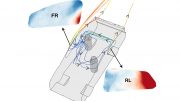
Scientists developed a smart window device for concurrently harvesting and regulating solar energy. Credit: Peter Allen / University of Chicago
A customizable smart window harnesses and manipulates solar power to save energy and cut costs.
Windows play multiple crucial roles in our homes. They illuminate, insulate, and ventilate our spaces while providing views of — and protection from — the outdoors. Smart windows, or windows that use solar cell technology to convert sunlight into electricity, present the additional opportunity to leverage windows as energy sources.
However, incorporating solar cells into windows while balancing the other complex, and often conflicting, roles of windows proves challenging. For example, juggling luminosity preferences and energy harvesting goals throughout changing seasons requires complex and strategic approaches to material design.
“This design framework is customizable and can be applied to virtually any building around the world.” — Junhong Chen, scientist at Argonne and professor at the University of Chicago’s Pritzker School of Molecular Engineering
Scientists from the U.S. Department of Energy’s (DOE) Argonne National Laboratory, Northwestern University, the University of Chicago and University of Wisconsin-Milwaukee recently combined solar cell technology with a novel optimization approach to develop a smart window prototype that maximizes design across a wide range of criteria.
The optimization algorithm uses comprehensive physical models and advanced computational techniques to maximize overall energy usage while balancing building temperature demands and lighting requirements across locations and throughout changing seasons.
“This design framework is customizable and can be applied to virtually any building around the world,” said Junhong Chen, a scientist at Argonne and the Crown Family Professor of Molecular Engineering at the Pritzker School of Molecular Engineering at the University of Chicago. “Whether you want to maximize the amount of sunlight in a room or minimize heating or cooling efforts, this powerful optimization algorithm produces window designs that align with user needs and preferences.”
Advanced approach to optimization
The scientists demonstrated a holistic approach to window design to maximize the overall energy efficiency of buildings while considering lighting and temperature preferences.
“We can regulate the sunlight in a room to ensure the desired luminosity while managing the amount of energy the building uses for heating and cooling,” said Wei Chen, the Wilson-Cook Professor in Engineering Design at Northwestern Engineering whose research group led the development of the optimization approach. “Additionally, the sunlight that doesn’t pass through is captured by the solar cell in the smart window and converted into electricity.”
The approach, called multicriteria optimization, adjusts the thicknesses of solar cell layers in window design to meet the needs of the user. For example, to reduce the energy required to cool a building in the summer, the optimal window design might minimize the amount and type of light passing through while maintaining the desired luminosity inside. On the other hand, when winter savings are a priority, the design might maximize the amount of sunlight that passes through, thereby reducing the energy required for heating the building.
“Rather than focusing only on the amount of electricity produced by the solar cell, we consider the entire building’s energy consumption to see how we can best use solar energy to minimize it,” said Wei Chen.
In some scenarios, for example, it might be more energy efficient to allow a greater amount of light to pass through the window, instead of being converted into electricity by the solar cell, in order to decrease the electricity required for lighting and heating the building.
To determine the optimal design, the algorithm incorporates comprehensive physics-based models of the interactions between light and the materials in the smart window, as well as how the processes affect energy conversion and light transmission. The algorithm also takes into account the varying angles at which the sun hits the window throughout the day — and year — in different geographical locations.
“The model we created allows for exploration of millions of unique designs by an algorithm that mimics biological evolution,” said Wei Chen. “On top of the physics-based models, the algorithm uses computational mechanisms that resemble reproduction and genetic mutation to determine the optimal combination of each design parameter for a certain scenario.”
Promising prototype
To demonstrate the feasibility of a smart window capable of this level of customization, the scientists produced a small prototype of the window with an area of a few square centimeters.
The prototype consists of dozens of layers of varying materials that control the amount and frequency of light passing through, as well as the amount of solar energy converted into electricity.
One group of layers, made of a type of material called a perovskite, comprises the window’s solar cell, which harvests sunlight for energy conversion. The window prototype also includes a set of layers called a nanophotonic coating, developed by associate professor of mechanical engineering Cheng Sun and his research group at Northwestern’s McCormick School of Engineering. The coating tunes the frequencies of light that can pass through the window.
Each layer is tens of microns thick — thinner than the diameter of a grain of sand. The scientists chose an aperiodic design for the layers, meaning each layer varies in thickness. As the angle of the sun’s rays against the window changes throughout the day and year, the aperiodic design enables the performance of the window to vary in accordance with the user’s preferences.
“The variation in layer thickness is optimized for a wide spectrum of change in the nature of the sunlight that reaches the window,” said Sun. “This enables us to systematically allow less infrared transmission in the summertime and more in the wintertime to save energy consumption for temperature regulation, while optimizing the visible transmission for the purpose of indoor lighting and energy harvesting.”
The scientists optimized the prototype used in this study for a 2,000-square-foot (186-square-meter), single-story home in Phoenix. Based on experimental characterization of the window prototype, the scientists calculated significant annual energy savings over leading commercially available window technologies. The calculations used the EnergyPlus building model, a software developed at the National Renewable Energy Laboratory, a DOE Office of Energy Efficiency and Renewable Energy laboratory, that estimates realistic power consumption over time.
The synthesis methods the scientists used to produce the window prototype mimic common industrial-level manufacturing processes, and the scientists believe that these existing commercial processes would allow for successful scaling of the window prototype to full-size.
Future considerations include developing the same technology in a flexible form so that the smart window materials can be retrofitted to cover preexisting windows.
Reference: “Maximizing solar energy utilization through multicriteria pareto optimization of energy harvesting and regulating smart window” by Chen Wang, Shuangcheng Yu, Xiaoru Guo, Tucker Kearney, Peijun Guo, Robert Chang, Junhong Chen, Wei Chen and Cheng Sun, 8 July 2020, Cell Reports, Physical Science.
DOI: 10.1016/j.xcrp.2020.100108
The work was funded in part by the National Science Foundation.









… some materials could be better at some wave lengths, so just get the best game plan…